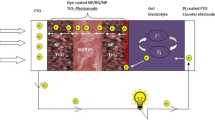Abstract
In this study, Nb-doped TiO2 nanoparticles were prepared by solution synthesis, and utilized as photoelectrode for dye-sensitized solar cell aiming to obtain better photon-to-current conversion efficiency. Nb doping was carried out using two different Nb precursors, and subsequent hydrothermal treatment resulted in the size-controlled (~10 nm) Nb-doped TiO2 nanoparticles with typical ellipsoidal shapes and anatase morphologies. It was observed that NbCl2 precursor resulted in more uniform particle size, while Nb oxalate resulted in relatively broader particle size distributions and higher aspect ratio ellipsoid. Using these nanoparticles, 10 μm-thick porous inverse opal (IO) photoelectrodes were fabricated by coating the mixed aqueous dispersions of Nb-TiO2 nanoparticles and polystyrene particles of 270 nm diameter on conductive glass followed by thermal sintering. DSSC single cell performance tests revealed that a photoelectrode from 2 mol% Nb- TiO2 obtained from NbCl2 exhibited 20 % enhancement for solar cell efficiency compared to bare TiO2 IO.





Similar content being viewed by others
References
Gratzel M (2005) Dye-sensitized solid-state heterojunction solar cells. MRS Bull 30:23–27
Morton O (2006) Solar energy: a new day dawning? Silicon valley sunrise. Nature 443:19–22
Mihi A, Calvo ME, Anta JA, Miguez H (2008) Spectral response of opal-based dye-sensitized solar cells. J Phys Chem C 112:13–17
Kwak ES, Lee W, Park NG, Kim J, Lee H (2009) Compact inverse-opal electrode using non-aggregated TiO2 nanoparticles for dye-sensitized solar cells. Adv Func Mater 19:1093–1099
Seo YG, Lee H, Kim K, Lee W (2010) Transparent thin films of anatase titania nanoparticles with high refractive indices prepared by wet coating process. Mol Cryst Liq Cryst 520:201–208
Seo YG, Woo J, Lee H, Lee W (2011) Rapid fabrication of an inverse opal TiO2 photoelectrode for DSSC using a binary mixture of TiO2 nanoparticles and polymer microspheres. Adv Funct Mater 21:3094–3103
Miyagi T, Kamei M, Sakaguchi I, Mitsuhashi T, Yamazaki A (2004) Photocatalytic property and deep levels of Nb-doped anatase TiO2 film grown by metalorganic chemical vapor depostion. Jpn J Appl Phys 1(43):775–776
Su H, Huang Y, Chang Y, Zhai P, Hau NY, Cheung PCH, Yeh W, Wei T, Feng S (2015) The synthesis of Nb-doped TiO2 nanoparticles for improved-performance dye-sensitized solar cells. Electrochim Acta 182:230–237
Quan LN, Jang YH, Jang YJ, Kim J, Lee W, Moon JH, Kim DH (2015) Mesoporous carbon-TiO2 beads with nanotextured surfaces as photoanodes in dye-sensitized solar cells. Chem Sus Chem 7:2590–2596
Horie Y, Watanabe T, Deguchi M, Asakura D, Nomiyama T (2013) Enhancement of carrier mobility by electrospun nanofibers of Nb-doped TiO2 in dye-sensitized solar cells. Electrochim Acta 105:394–402
Chun JH, Kim JS (2014) Comparison of different structures of niobium oxide blocking layer for dye-sensitized solar cells. J Nanosci Nanotech 14:6226–6230
Lim SH, Park KW, Jin MH, Ahn S, Song J, Hong J (2015) Facile preparation of a Nb2O5 blocking layer for dye-sensitized solar cells. J Electroceramics 34:221–227
Kim S, Seo YG, Cho Y, Shin J, Gil SC, Lee W (2010) Optimization of emulsion polymerization for submicron-sized polymer colloids towards tunable synthetic opals. Bull Kor Chem Soc 31:1891–1896
Lee W, Kim I, Ok I, Ahn D, Lee H, Kim JH, Kim K (2014) Solution processed thin films of Nb-doped TiO2 nanoparticles as hole blocking layer for organic solar cells. Thin Solid Films 553:161–165
Kubacka A, Colon G, Fernandez-Garcia M (2009) Cationic (V, Mo, Nb, W) doping of TiO2-anatase: a real alternative for visible light-driven photocatalysts. Catal Today 143:286–292
Das P, Sengupta D, Kasinadhuni U, Mondal B, Mukherjee K (2015) Nano-crystalline thin and nano-particulate thick TiO2 layer: cost effective sequential deposition and study on dye-sensitized solar cell characteristics. Mater Res Bull 66:32–38
Acknowledgments
This study was financially supported by Basic Science Research Program through the National Research Foundation of Korea (NRF) funded by the Ministry of Education, Science and Technology (2013R1A1A2011168), and partially supported by Civil Military Technology Cooperation Center (CMTC) (15-CM-EN-08).
Author information
Authors and Affiliations
Corresponding authors
Electronic supplementary material
Below is the link to the electronic supplementary material.
Rights and permissions
About this article
Cite this article
Lee, W., Kim, S., Kang, J. et al. Inverse opal photoelectrode of Nb-doped TiO2 nanoparticles for dye-sensitized solar cell. Polym. Bull. 73, 2547–2555 (2016). https://doi.org/10.1007/s00289-016-1684-5
Received:
Revised:
Accepted:
Published:
Issue Date:
DOI: https://doi.org/10.1007/s00289-016-1684-5




